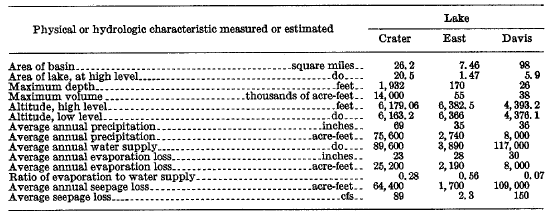Hydrology of Crater, East and Davis Lakes, Oregon by Kenneth N. Phillips
ABSTRACT
Crater, East, and Davis Lakes are small bodies of fresh water that occupy topographically closed basins in Holocene volcanic terranes. Because the annual water supply exceeds annual evaporation, water must be lost by seepage from each lake. The seepage rates vary widely both in volume and in percentage of the total water supply. Crater Lake loses about 89 cfs (cubic feet per second), equivalent to about 72 percent of its average annual supply. East Lake loses about 2.3 cfs, or about 44 percent of its estimated supply. Davis Lake seepage varies greatly with lake level, but the average loss is about 150 cfs, more than 90 percent of its total supply. The destination of the seepage loss is not definitely known for any of the lakes.
An approximate water budget was computed for stationary level for each lake, by using estimates by the writer to supplement the hydrologic data available. The three lake waters are dilute. Crater Lake contains about 80 ppm (parts per million) of dissolved solids-mostly silica, sodium, and bicarbonate, and lesser amounts of calcium, sulfate, and chloride. Much of the dissolved-solids content of Crater Lake especially the sulfate and chloride-may be related to fumarole and thermal-spring activity that presumably followed the collapse of Mount Mazama. Although Crater Lake loses an estimated 7,000 tons of its 1.5-million-ton salt content each year by leakage, the chemical character of the lake did not change appreciably between 1912 and 1964. East Lake contains 200 ppm of dissolved solids, which includes major proportions of calcium, sodium, bicarbonate, and sulfate, but almost no chloride. The lake apparently receives much of its dissolved solids from subsurface thermal springs. Annual solute loss from East Lake by leakage is about 450 tons, or 3 percent of the lake’s 15,000-ton estimated solute content. Davis Lake contains only 48 ppm of dissolved solids, much of which is silica and bicarbonate; chloride is almost completely absent.
Approximate physical and hydrologic data for the lakes are summarized in the following table.
***previous*** — ***next***


